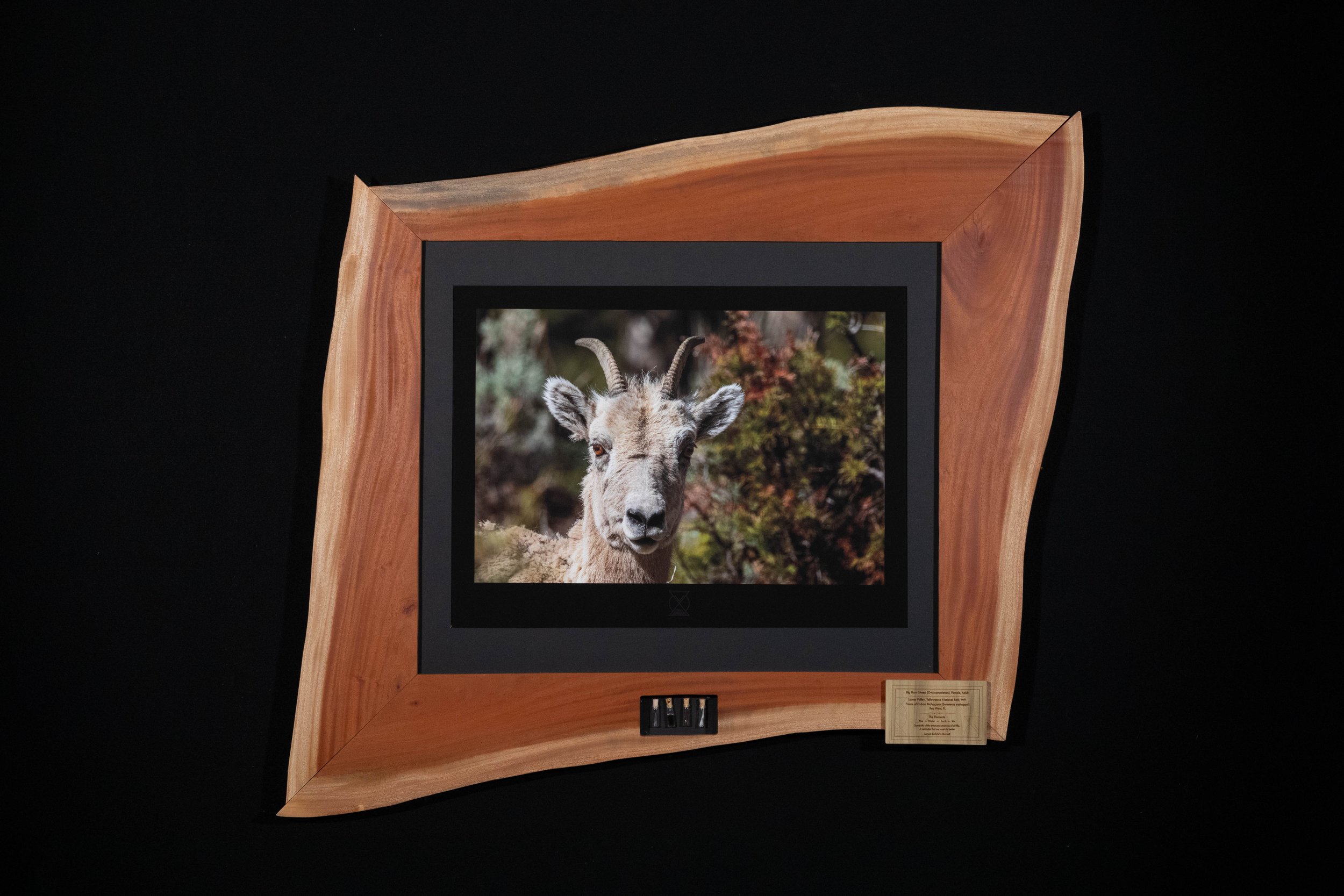Bighorn Sheep (Ovis canadensis), Female, Adult - Lamar Valley, Yellowstone National Park, WY




Bighorn Sheep (Ovis canadensis), Female, Adult - Lamar Valley, Yellowstone National Park, WY
Bighorn Sheep (Ovis canadensis), Female, Adult
I walked along through the edge of the woods for a while slowly following a group of Bighorn Sheep. This one finally paused from eating to look up at me for some seconds. This photo was taken 5/16/21 at 4:00 pm.
WeForest Donation: $320 (What is this?)
Print Number: 1/3
Print Size: 15 x 22.5
Total Dimensions: 39 x 43
Hanging equipment and certificate of authenticity included.
PHOTOGRAPH
Bighorn Sheep (Ovis canadensis)
Ranging from South Western Canada to Western Mexico and all through the Western United States, their territory stretches as far East as Badlands National Park, SD. Although not found throughout this range, Bighorn Sheep are prevalent in small patches of mountainous land throughout this area. While prevalent they are not necessarily easy to find. Whether they are Desert, Sierra Nevada, or Rocky Mountain subspecies, they thrive in rural, rugged, high elevation terrain. These three subspecies can; however, vary in size quite a bit. Sierra Nevada Bighorn Sheep, found in the Sierra Nevada Mountains in California, are the smallest of the three by far, males only getting up to about 200 pounds. Rocky Mountain Bighorn Sheep on the other hand get up to nearly 500 pounds. They are also much more common and are the Bighorn Sheep that are seen throughout the United States and Canadian Territory. Desert Bighorns are found in the Southwestern United States and in their Mexican range.
LOCATION
Yellowstone National Park, WY
Established in 1872, Yellowstone National Park was the first national park in the United States, and has thus been one for about 150 years. For 10,000 years before, the land was home to many Indigenous Tribes, and many more animals than inhabit the area today. A convergence of the The Great Basin, The Great Plains, and the Columbia Plateau, it is still a special place in this country with a wide array and abundance of life. Having been expanded and more heavily protected over the last century and a half, Yellowstone National Park today stands as the largest intact temperate-zone ecosystems on the planet, preserves over 10,000 hydrothermal features, more than the rest of the planet combined, and is home to the largest concentration of wildlife in the lower 48 states of the United States. That last fact is extremely evident when you are there in person. Although consistently a top 10 most frequented park with between 3 and 4 million visitors annually, the wildlife still exists in droves. I have never experienced the feeling of looking into the past that I feel when I am in Yellowstone. One truly gets a glimpse into the world that existed throughout the United States before this land became the United States. Animals interact with each other and exist in numbers that you simply don’t see throughout the rest of the country. I try to visit once a year to see the ever quickening changes and collect more photos of one of my favorite places I have ever visited.
FRAME
Cuban Mahogany (Swietenia mahagoni)
Cuban Mahogany is one of three species of Mahogany and it was originally the most widely used of the three. Nowadays, Honduran Mahogany is the much more prevalent wood and what most people would recognize as Mahogany. Native to the Carribbean, Cuban Mahogany’s northernmost range does include the far south of Florida, including the Keys. I happen to get all of my Cuban mahogany from a salvager in the Keys who removes the trees from construction sites before cutting it into slabs and drying it.
THE ELEMENTS
Fire, Water, Earth, and Air
In the display case in the bottom of the frame, four items are preserved glass vials. The items represent the elements: fire (wood charcoal), water (mineral oil), earth (soil), and air (a milkweed seed). I include these items in my work as a symbol of the interconnectedness of all life on earth, and as a reminder that humans must do better.
The Plaque
I engrave a wooden information plaque for each work. The plaque includes what the photograph is of, the location of the photograph, what type of wood the frame is made of and where I got the wood from. The plaques also explain what the vials are in each display case, and even state the meaning of my logo. The plaques are attached magnetically and can be removed to read or to store on the back of each frame if you prefer not to have it displayed on the front.

